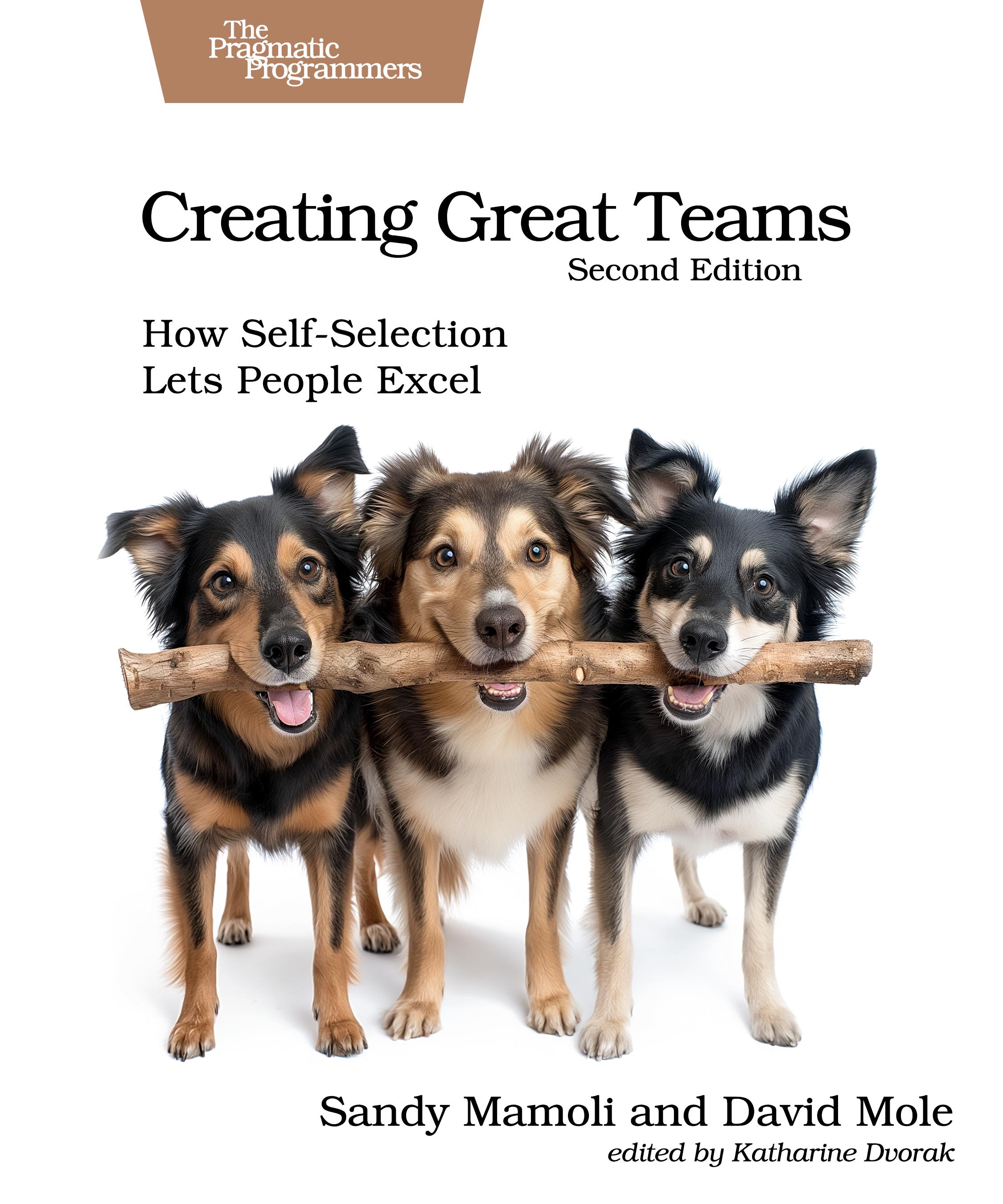Creating Great Teams, Second Edition
How Self-Selection Lets People Excel
by: Sandy Mamoli and David Mole
| Published | 2025-03-26 |
|---|---|
| Internal code | mmteams2 |
| Print status | In Print |
| Pages | 180 |
| User level | Intermediate |
| Keywords | cross-functional, self-selection, team, pairs, agile, methodology, project management, workplace culture |
| Related titles | Project Lifecycles: How to Reduce Risks, Release Successful Products, and Increase Agility Agile Retrospectives: Making Good Teams Great The Agile Samurai: How Agile Masters Deliver Great Software Program Management for Open Source Projects: How to Guide Your Community-Driven, Open Source Project From Chaos to Successful Distributed Agile Teams |
| ISBN | 9798888651339 |
| Other ISBN |
Channel epub: 9798888651667 |
| BISACs | COM051430BUS097000BUS097000 |
Highlight
People are happiest and most productive if they can choose what they work on and who they work with. Self-selecting teams give people that choice. Build well-designed and efficient teams to get the most out of your organization, with step-by-step instructions on how to set up teams quickly and efficiently. This new edition highlights ten years of additional insights, real-world case studies, and adaptations for remote and hybrid environments. Learn from the successes and challenges faced by organizations worldwide as they implemented self-selection, and discover a practical roadmap to unlocking team potential and fostering a culture of autonomy and engagement.
Description
Discover the transformative power of self-selection in building high-performing, motivated teams. Whether you’re a manager seeking to revitalize your team, an HR professional looking to innovate recruitment, or a leader aiming to cultivate a more agile and responsive organization, this book offers the tools and insights necessary to create teams that excel.
Learn to implement a self-selection event, a revolutionary approach that forms teams based on mutual interests and strengths, leading to increased levels of engagement and productivity. Adapt self-selection processes for remote and hybrid environments. Use step-by-step guidance on preparing for, executing, and following up on self-selection events to ensure smooth transitions and high team performance. Address common obstacles in team formation with innovative solutions that foster dynamic, resilient, and high-performing teams.
This updated edition enriches the original groundbreaking concepts with a decade’s worth of fresh insights, expanded case studies, and strategies for navigating the complexities of remote and hybrid work environments. Through a blend of practical advice and real-world examples, the book equips you with everything you need to implement self-selection in your organization. From the initial groundwork and planning phases to executing self-selection events, and the crucial steps that follow, you’ll learn how to create environments where people choose their teams, fostering a sense of ownership, satisfaction, and dynamism.
Contents and Extracts
- Preface
- Understanding the Core Concept
- Self-Selection and the Art of Dynamic Team Design excerpt
- What Is Self-Selection?
- A Decade of Self-Selection
- The Art of Team Design
- Self-Selection vs. Managerial Selection
- The Ideas Behind Self-Selection Are Not New
- Why Self-Selection Works
- What Next?
- Self-Selection in Action: A Trade Me Story
- Who Are We?
- What Problem Did We Need to Solve?
- Sparking the Idea
- The Trial
- Getting Away with It: Overcoming Fears and Skepticism
- How Self-Selection Unfolded
- Observation: How Did People Choose?
- The Impact and Results
- Embracing Self-Selection
- What Next?
- Self-Selection and the Art of Dynamic Team Design excerpt
- Mastering the Self-Selection Method
- Laying the Groundwork excerpt
- Self-Selection at Scale
- Step 1: Conduct a Readiness Check
- Step 2: Carry Out a Trial
- Step 3: Get Permission
- Step 4: Define the Teams to Select
- Step 5: Coordinate Logistics
- Step 6: Communicate Early and Often
- What Next?
- Getting Ready
- Step 1: Define the Rules and Constraints
- Step 2: Create a Facilitation Plan
- Step 3: Prepare Frequently Asked Questions
- Step 4: Send Out Homework
- Step 5: Prepare Materials and Stationery
- What Next?
- Running a Self-Selection Event
- Step 1: Set Up the Room
- Step 2: Welcome People as They Arrive
- Step 3: Introduce the Day
- Step 4: Product Owners Pitch
- Step 5: Explain the Rules
- Step 6: Get Started: One, Two, Three, Go!
- Step 7: Conduct a Checkpoint Review
- Step 8: Rinse and Repeat
- Step 9: Tackle the Outstanding Problems
- Step 10: Wrap Up
- What Next?
- Running a Remote or Hybrid Self-Selection Event
- Adapting to Remote and Hybrid Settings
- Three Critical Areas to Get Right
- Self-Selecting in a Remote Environment
- Self-Selecting in a Hybrid Environment
- What Next?
- After Self-Selection: Now What?
- Protect the Outcome
- Meet with New Teams ASAP
- Move Forward at Pace
- Schedule Team Launch Events
- Make the Overall Change Plan Visible
- Plan for Kicking Off New Teams
- Each Team Needs a Launch Event
- Support Teams After Launching
- What Not To Do
- What Next?
- Laying the Groundwork excerpt
- Learning from a Decade of Self-Selection
- Adapting Self-Selection to Your Context excerpt
- Understanding Your Unique Landscape
- Self-Selection in a SAFe Environment
- Self-Selection Using the unFIX Model
- Self-Selection to Boost Innovation and Employee Engagement
- Self-Selection to Merge and Reallocate Resources
- Self-Selection with LeSS
- Self-Selection with FAST Agile
- What Next?
- Insights: Lessons We Have Learned
- How Self-Selection Affects People
- Long-Term Benefits of Self-Selection
- How to Screw It Up
- What Next?
- Keeping the Spirit Alive
- Reality Check: Teams Will Evolve
- Sustaining Self-Selection: A Continuous Cycle
- Self-Selection Can Spread to More Than Just Teams
- Close Teams with Care Before Starting New Ones
- Create a Self-Selecting Vision for the Future
- Now It’s Your Turn
- What Would You Do If You Weren’t Afraid?
- Help Spread the Word
- Adapting Self-Selection to Your Context excerpt
